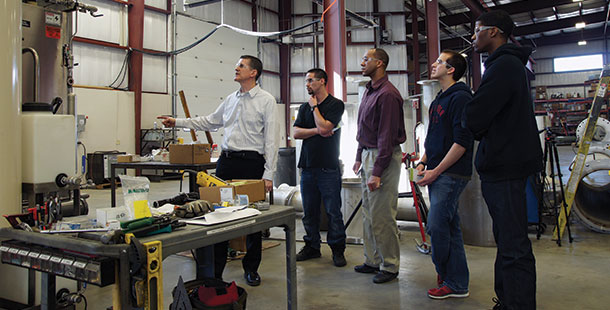Science, technology, engineering, and mathematics (STEM) fields are predominantly male and white. A 2010 report from the National Science Foundation shows that underrepresented minorities earn only 12.6 percent of all engineering bachelor’s degrees. Women, make up only 25 percent of the STEM workforce.
Initiatives like the Wisconsin Alliance for Minority Participation (WiscAMP) are created to change that. A program offered at Madison College, it was specifically created in 2004 to provide solutions for the issues affecting racial minorities in STEM.
The grant-funded program supports a specific number of students who are interested in transferring to a four-year college in a STEM field, specifically students who are classified as underrepresented minorities in those fields.
In the past two years, WiscAMP has supported a group of five student scholars each year at Madison College. Students that fit the profile can apply through the website. They must be planning to transfer to a four-year college in a STEM discipline, have gotten through college algebra and received a 2.6 or higher GPA.
According to the website, the program aims to “increase retention through academic enhancement programs and services that focus on tutoring, mentoring, supplemental instruction and peer support.”
For Bethany Sansing-Helton, math instructor and co-coordinator of the WiscAMP scholars program at Madison College, women and minorities face a lot of barriers. The difficulties minorities start in the classroom where they can feel isolated and unwelcome because of the lack of peer and teaching representation.
“It’s hard when you’re in a class where there is nobody else like you in the class; it’s really hard to feel like you belong. There is this constant feeling of maybe I don’t belong here,” she said.
To make the students feel integrated and supported there are monthly meetings to create a sense of belonging. Also the program offers individual mentorship. The mentors are usually from minorities and female. Students can look at their mentors and have the proof that their goal to integrate STEM fields can be achieved.
Jorge Lara Santiago, a student from Mexico and a WiscAMP student scholar, finds this mentorship helpful. His mentor, Jeff Galligan, helps with anything related to school time management and stress.
“He guides me, and as a mentor does a great job at doing so. We meet every Friday to check on how I am doing. Are my grades ok? Is this class doing well?”
Santiago also benefits from the internship opportunity, by working at a lab at UW-Madison of his chosen discipline, biomedical engineering. The internship allows students to practice in the field they are interested in. Students can also choose to do a research project.
The program also supports the students financially with a $4,800 stipend for a year. The stipend helps Lara Santiago who can now also contribute to the funding of his education, removing the burden from his parents.
Keshena Koran, a Native-American student from Menominee, is also a scholar who wants to major in environmental chemical engineering. Like Santiago, she chose to intern in a lab on the UW campus.
“I am conducting experiments to test the viability of nano particle coatings they have been developing to use in extending the life of lithium ion batteries,” she said.
Koran says that while the stipend is great, the internship requirement gives her a chance to have hands on experience and open her eyes to what she may be doing once she graduates.
Another problem that can affect the academic success of minority students is the miscommunication between teachers and students due to cultural differences. To solve this problem, there will be faculty-training sessions in the fall. According to Sansing-Helton the focus will be on how to work with a diverse student body, specifically the STEM faculty.
Despite the inequalities and difficulties that minorities and female students must face to access STEM field spaces, Sansing-Helton remains optimistic. She stopped being an engineer to try to get a more diverse population in STEM fields.
Another statistic from the National Science Foundation shows that 50 percent of the underrepresented minority male population starts at a two-year college. According to Sansing-Helton, this gives an opportunity for two-year colleges like Madison College to make a big impact on students’ success by giving them the support that they need.
She describes the program as somewhere the students can turn to for help: a safety net.
“I really feel like our program, even though it’s fairly small – I feel like it’s making a big difference for our students.”
Next fall, only four students will be selected for the program, due to budget restrictions. Monthly meetings will be accessible to more students who fit the profile of eligibility.
The deadline to apply to the program is April, 30.


























